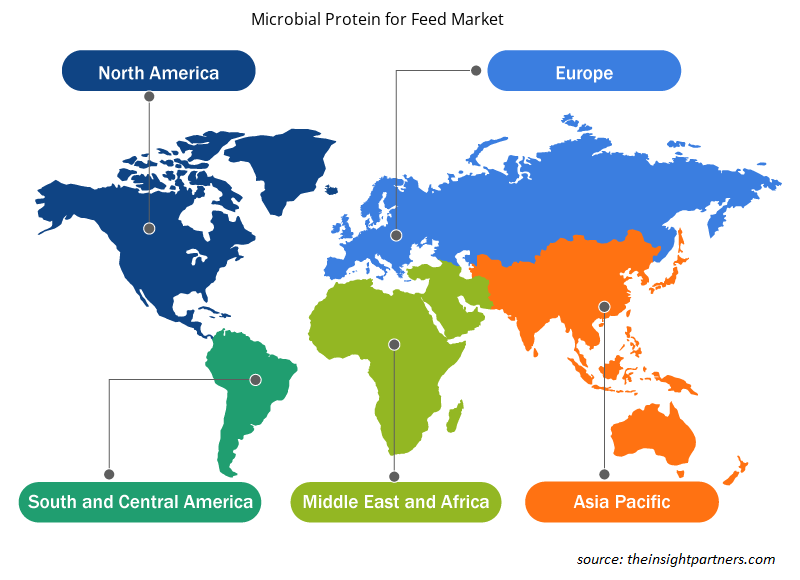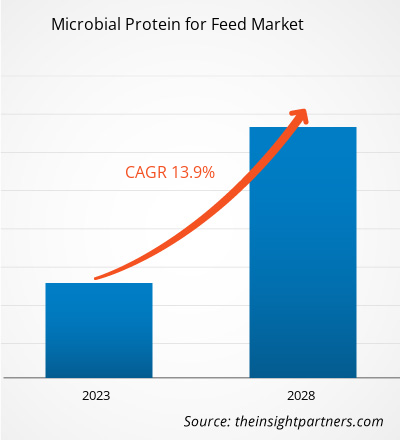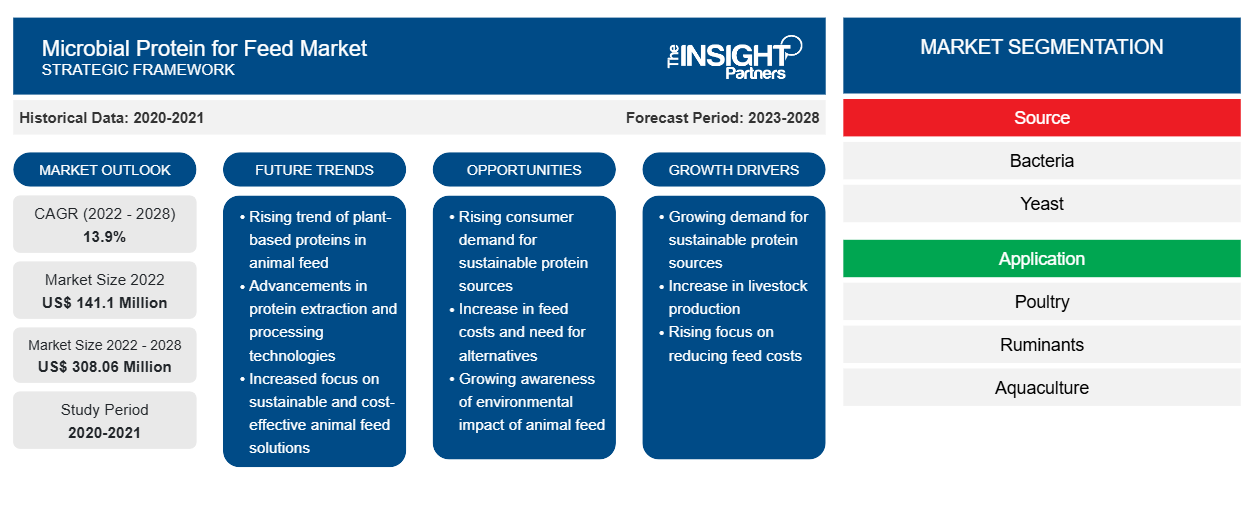من المتوقع أن ينمو حجم سوق البروتين الميكروبي للأعلاف من 141،095.88 ألف دولار أمريكي في عام 2022 إلى 308،055.17 ألف دولار أمريكي بحلول عام 2028؛ ومن المتوقع أن يسجل معدل نمو سنوي مركب بنسبة 13.9٪ من عام 2022 إلى عام 2028.
يعد البروتين الميكروبي أحد المصادر المهمة للبروتين الخام. هناك العديد من الفوائد الغذائية لإدراج البروتين الميكروبي في الأعلاف الحيوانية . يحتوي البروتين الميكروبي على أكثر من 70٪ من البروتين الخام، في حين يحتوي دقيق الصويا على 40-50٪ من البروتين الخام، ويحتوي دقيق السمك على 60-65٪ من البروتين الخام. علاوة على ذلك، فإنه يحتوي على ملف مثالي للأحماض الأمينية، بما في ذلك الفالين الأعلى، والتريبتوفان، والأيزوليوسين، والليوسين مقارنة بوجبات السمك. يعد البروتين الميكروبي أحد البدائل الممتازة للمصادر التقليدية للبروتينات مثل فول الصويا ودقيق السمك. يتم إنتاجه باستخدام ركائز فعالة من حيث التكلفة مثل الغازات الصناعية (ثاني أكسيد الكربون، والميثان، والغاز الطبيعي)، ومياه الصرف الصحي، ونفايات الدواجن (الريش) المخمرة في مفاعل باستخدام البكتيريا أو الخميرة أو الفطريات أو الطحالب الدقيقة. وبالتالي، فإن الفوائد الغذائية المختلفة لإضافة البروتين الميكروبي إلى أنظمة الماشية الغذائية ومخاوف الاستدامة المتزايدة تدفع نمو سوق البروتين الميكروبي للأعلاف .
في عام 2021، استحوذت أوروبا على أكبر حصة من سوق البروتين الميكروبي العالمي للأعلاف. ووفقًا لاتحاد مصنعي الأعلاف الأوروبيين (FEFAC)، زاد إنتاج أعلاف الخنازير بنسبة 2.9٪ في عام 2020، على الرغم من استمرار انتشار حمى الخنازير الأفريقية (ASF) في المنطقة وتأثيرها على تربية الخنازير. زادت العديد من الدول الأوروبية صادراتها إلى الصين، مستفيدة من حظر التصدير في ألمانيا، مما أدى إلى زيادة إنتاج أعلاف الخنازير في عام 2020. مع ارتفاع مستويات إنتاج الأعلاف الحيوانية، يبحث المصنعون عن إضافات أعلاف مستدامة، حيث لا يُنظر إلى إضافات الأعلاف ذات المصدر الحيواني والنباتي على أنها صديقة للبيئة في الوقت الحاضر. تهدد مواد الأعلاف المستوردة، مثل فول الصويا، الموارد الطبيعية والتنوع البيولوجي. وبالتالي، يتزايد الطلب على البروتين الميكروبي بين مصنعي الأعلاف الحيوانية.
قم بتخصيص هذا التقرير ليناسب متطلباتك
ستحصل على تخصيص لأي تقرير - مجانًا - بما في ذلك أجزاء من هذا التقرير، أو تحليل على مستوى الدولة، وحزمة بيانات Excel، بالإضافة إلى الاستفادة من العروض والخصومات الرائعة للشركات الناشئة والجامعات
-
احصل على أهم اتجاهات السوق الرئيسية لهذا التقرير.ستتضمن هذه العينة المجانية تحليلاً للبيانات، بدءًا من اتجاهات السوق وحتى التقديرات والتوقعات.
تأثير جائحة كوفيد-19 على سوق البروتين الميكروبي للأعلاف
واجهت صناعة الأعلاف تحديات حاسمة مثل نقص المواد الخام والعمال، وارتفاع أسعار المواد الخام، وانقطاعات شبكات التوزيع بسبب عمليات الإغلاق، وحظر السفر، والقيود التجارية، وإغلاق وحدات التصنيع، وغيرها من القيود التي فرضتها الحكومات في جميع أنحاء العالم. وقد أعاق هذا أنشطة التصنيع لمختلف الشركات في صناعة الأعلاف الحيوانية، مما أدى لاحقًا إلى زيادة أسعار مكونات الأعلاف. في الاتحاد الأوروبي، أشار حوالي ثلثي الدول الأعضاء إلى ارتفاع أسعار الأعلاف في صناعة الثروة الحيوانية أثناء الوباء. علاوة على ذلك، خلال ذروة الوباء، أغلقت الصين أسواق تجارة الماشية والدواجن والذبح في معظم المناطق. أعاقت مثل هذه الحواجز في صناعة الثروة الحيوانية الطلب على مكونات الأعلاف مما كان له تأثير سلبي على الطلب على البروتين الميكروبي للأعلاف أثناء الوباء.
في عام 2021، استأنفت اقتصادات مختلفة عملياتها بعد أن أعلنت حكوماتها تخفيف القيود المفروضة سابقًا، مما عزز السوق العالمية. علاوة على ذلك، سُمح للمصنعين بالعمل بكامل طاقتهم، مما ساعدهم في التغلب على فجوة العرض والطلب وغيرها من التداعيات.
رؤى السوق
استثمارات الحكومة والقطاع الخاص سيكون لها تأثير إيجابي على نمو سوق البروتين الميكروبي للأعلاف
إن تغير المناخ والاستغلال المفرط للموارد الطبيعية مثل الأرض والمياه هي المخاوف الرئيسية المتعلقة بالاستدامة في صناعات الثروة الحيوانية والأعلاف الحيوانية. ونتيجة لذلك، تقوم حكومات مختلف البلدان في جميع أنحاء العالم بتمويل الشركات التي تصنع الأعلاف الحيوانية والمكونات باستخدام ممارسات مستدامة للحد من بصمتها الكربونية الإجمالية ودعم نمو الاقتصاد الدائري. كما تدعم الحكومات والمستثمرون من القطاع الخاص الشركات التي تصنع بروتين الأعلاف الحيوانية من الكائنات الحية الدقيقة لأنها واحدة من أكثر مصادر البروتين استدامة لتغذية الحيوانات. على سبيل المثال، في فبراير 2022، تلقت شركة Arbiom - وهي شركة فرنسية أمريكية لتصنيع البروتينات عالية الجودة لأعلاف الحيوانات وتطبيقات الأغذية من خلال معالجة النفايات الزراعية وبقايا الخشب - استثمارًا بقيمة 13.50 مليون دولار أمريكي من برنامج الاستثمار France Relance. بعد تلقي الاستثمار، أعلنت الشركة عن بناء أول مصنع إنتاج تجاري لها في فرنسا. وبالتالي، من المتوقع أن يؤثر الاستثمار المتزايد من الحكومة والقطاع الخاص في سوق البروتين الميكروبي للأعلاف بشكل إيجابي على نمو السوق خلال الفترة المتوقعة.
رؤى المصدر
بناءً على المصدر، يتم تقسيم سوق البروتين الميكروبي العالمي للأعلاف إلى البكتيريا والخميرة وغيرها. احتل قطاع البكتيريا الحصة الأكبر من سوق البروتين الميكروبي العالمي للأعلاف في عام 2021 ومن المتوقع أن يسجل أعلى معدل نمو سنوي مركب من عام 2022 إلى عام 2028. تظهر البكتيريا أعلى معدلات نمو مقارنة بالخميرة والكائنات الحية الدقيقة الأخرى. علاوة على ذلك، فإن كمية البروتين المنتجة باستخدام الثقافة البكتيرية هي الأكبر. علاوة على ذلك، يحتوي على أكثر من 70٪ من البروتين الخام وله ملف تعريف الأحماض الأمينية الأساسية المواتية. وفقًا لدراسات مختلفة، تنتج 1000 كجم من البكتيريا جودة أعلى من البروتينات من فول الصويا والماشية. وبالتالي، تعد البكتيريا واحدة من المصادر الأكثر فعالية من حيث التكلفة والأسرع للبروتين للأعلاف الحيوانية. كل هذه العوامل تدفع سوق هذا القطاع.
تشمل الجهات الفاعلة الرئيسية العاملة في سوق البروتين الميكروبي العالمي للأعلاف شركة Calysta, Inc.؛ وAvecom؛ وArbiom؛ وKnipBio؛ وICC؛ وAlltech. يركز اللاعبون في السوق على توفير منتجات عالية الجودة لتلبية طلب العملاء. كما يركزون على استراتيجيات مثل الاستثمارات في أنشطة البحث والتطوير والشراكات والتوسع.
البروتين الميكروبي المستخدم في الأعلاف
رؤى إقليمية حول سوق البروتين الميكروبي للأعلاف
لقد قام المحللون في Insight Partners بشرح الاتجاهات والعوامل الإقليمية المؤثرة على سوق البروتين الميكروبي للأعلاف طوال فترة التوقعات بشكل شامل. يناقش هذا القسم أيضًا قطاعات سوق البروتين الميكروبي للأعلاف والجغرافيا في جميع أنحاء أمريكا الشمالية وأوروبا ومنطقة آسيا والمحيط الهادئ والشرق الأوسط وأفريقيا وأمريكا الجنوبية والوسطى.

- احصل على البيانات الإقليمية المحددة لسوق البروتين الميكروبي للأعلاف
نطاق تقرير سوق البروتين الميكروبي للأعلاف
| سمة التقرير | تفاصيل |
|---|---|
| حجم السوق في عام 2022 | 141.1 مليون دولار أمريكي |
| حجم السوق بحلول عام 2028 | 308.06 مليون دولار أمريكي |
| معدل النمو السنوي المركب العالمي (2022 - 2028) | 13.9% |
| البيانات التاريخية | 2020-2021 |
| فترة التنبؤ | 2023-2028 |
| القطاعات المغطاة |
حسب المصدر
|
| المناطق والدول المغطاة |
أمريكا الشمالية
|
| قادة السوق وملفات تعريف الشركات الرئيسية |
|
كثافة اللاعبين في سوق البروتين الميكروبي للأعلاف: فهم تأثيره على ديناميكيات الأعمال
يشهد سوق البروتين الميكروبي للأعلاف نموًا سريعًا، مدفوعًا بالطلب المتزايد من المستخدم النهائي بسبب عوامل مثل تفضيلات المستهلكين المتطورة والتقدم التكنولوجي والوعي المتزايد بفوائد المنتج. ومع ارتفاع الطلب، تعمل الشركات على توسيع عروضها والابتكار لتلبية احتياجات المستهلكين والاستفادة من الاتجاهات الناشئة، مما يؤدي إلى زيادة نمو السوق.
تشير كثافة اللاعبين في السوق إلى توزيع الشركات أو المؤسسات العاملة في سوق أو صناعة معينة. وهي تشير إلى عدد المنافسين (اللاعبين في السوق) الموجودين في مساحة سوق معينة نسبة إلى حجمها أو قيمتها السوقية الإجمالية.
الشركات الرئيسية العاملة في سوق البروتين الميكروبي للأعلاف هي:
- شركة كاليستا
- افيكوم
- أربيوم
- كنيب بيو
- المحكمة الجنائية الدولية
إخلاء المسؤولية : الشركات المذكورة أعلاه ليست مرتبة بأي ترتيب معين.

- احصل على نظرة عامة على أهم اللاعبين الرئيسيين في سوق البروتين الميكروبي للأعلاف
التطوير الرئيسي:
في يونيو 2022، شكلت شركة Calysta Inc. وAdisseo مشروعًا مشتركًا (JV)، "Calysseo"، لبدء أول منشأة إنتاجية على نطاق صناعي في تشونغتشينغ، الصين، لإنتاج 20 ألف طن من FeedKind، وهو بروتين ميكروبي للأعلاف المائية، سنويًا. مع الإنتاج والتوزيع الناجح لـ FeedKind في الصين، يخطط شركاء المشروع المشترك لتوسيع الطاقة الإنتاجية إلى 80 ألف طن سنويًا في السنوات القادمة.
تقرير يسلط الضوء على
- الاتجاهات الصناعية التقدمية في سوق البروتين الميكروبي للأعلاف لمساعدة اللاعبين على تطوير استراتيجيات فعالة طويلة الأجل
- استراتيجيات نمو الأعمال التي تتبناها البلدان المتقدمة والنامية
- التحليل الكمي لسوق البروتين الميكروبي للأعلاف من 2020 إلى 2028
- تقدير الطلب العالمي على البروتين الميكروبي للأعلاف
- تحليل PEST لتوضيح العوامل السياسية والاقتصادية والاجتماعية والتكنولوجية التي تؤثر على نمو سوق البروتين الميكروبي العالمي للأعلاف.
- التطورات الأخيرة لفهم سيناريو السوق التنافسي
- اتجاهات السوق وتوقعاتها، فضلاً عن العوامل التي تدفع وتكبح نمو سوق البروتين الميكروبي للأعلاف
- المساعدة في عملية اتخاذ القرار من خلال تسليط الضوء على استراتيجيات السوق التي تدعم المصلحة التجارية، مما يؤدي إلى نمو السوق
- حجم سوق منتجات التسمير الذاتي في مختلف العقد
- نظرة عامة مفصلة وتقسيم السوق، بالإضافة إلى ديناميكيات صناعة البروتين الميكروبي للأعلاف
- حجم سوق البروتين الميكروبي للأعلاف في مناطق مختلفة مع فرص نمو واعدة
- التحليل التاريخي (سنتان)، سنة الأساس، التوقعات (7 سنوات) مع معدل النمو السنوي المركب
- تحليل PEST و SWOT
- حجم السوق والقيمة / الحجم - عالمي، إقليمي، بلد
- الصناعة والمنافسة
- مجموعة بيانات إكسل
التقارير الحديثة
تقارير ذات صلة
شهادات العملاء
سبب الشراء
- اتخاذ قرارات مدروسة
- فهم ديناميكيات السوق
- تحليل المنافسة
- رؤى العملاء
- توقعات السوق
- تخفيف المخاطر
- التخطيط الاستراتيجي
- مبررات الاستثمار
- تحديد الأسواق الناشئة
- تحسين استراتيجيات التسويق
- تعزيز الكفاءة التشغيلية
- مواكبة التوجهات التنظيمية























 احصل على عينة مجانية ل - البروتين الميكروبي لسوق الأعلاف
احصل على عينة مجانية ل - البروتين الميكروبي لسوق الأعلاف